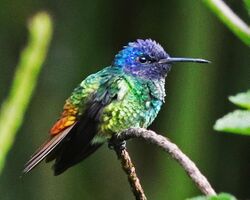Biology:Chrysuronia
| Chrysuronia | |
|---|---|

| |
| Golden-tailed sapphire, (Chrysuronia oenone) | |
| Scientific classification | |
| Domain: | Eukaryota |
| Kingdom: | Animalia |
| Phylum: | Chordata |
| Class: | Aves |
| Clade: | Strisores |
| Order: | Apodiformes |
| Family: | Trochilidae |
| Tribe: | Trochilini |
| Genus: | Chrysuronia Bonaparte, 1850 |
| Type species | |
| Ornismya oenone (golden-tailed sapphire) Lesson, R, 1832
| |
| Species | |
|
9, see text | |
Chrysuronia is a genus of hummingbirds in the family Trochilidae, all of which are native to Central and South America.
Taxonomy
The genus Chrysuronia was introduced in 1850 by the French naturalist Charles Lucien Bonaparte.[1] Bonaparte did not specify a type species but this was designated as the golden-tailed sapphire in 1855 by George Robert Gray.[2][3] The genus name is a portmanteau of the specific names of two synonyms of the golden-tailed sapphire: Ornismya chrysura Lesson, R, 1832 and Ornismia oenone Lesson, 1832.[4]
This genus formerly included only a single species, the golden-tailed sapphire. A molecular phylogenetic study published in 2014 found that the genera Amazilia and Lepidopyga were polyphyletic.[5] In the revised classification to create monophyletic genera, Chrysuronia was broadened to include species that had previous been placed in Amazilia, Hylocharis and Lepidopyga.[6][7]
The genus now contains nine species:[6]
- Shining-green hummingbird (Chrysuronia goudoti) – formerly in Lepidopyga
- Golden-tailed sapphire (Chrysuronia oenone)
- Versicolored emerald (Chrysuronia versicolor) – formerly in Amazilia
- Sapphire-throated hummingbird (Chrysuronia coeruleogularis) – formerly in Lepidopyga
- Sapphire-bellied hummingbird (Chrysuronia lilliae) – formerly in Lepidopyga
- Humboldt's sapphire (Chrysuronia humboldtii) – formerly in Hylocharis
- Blue-headed sapphire (Chrysuronia grayi) – formerly in Amazilia
- White-chested emerald (Chrysuronia brevirostris) – formerly in Amazilia
- Plain-bellied emerald (Chrysuronia leucogaster) – formerly in Amazilia
References
- ↑ Bonaparte, Charles Lucien (1850) (in Latin). Conspectus Generum Avium. 1. Leiden: E.J. Brill. p. 75. https://www.biodiversitylibrary.org/page/43560118.
- ↑ Gray, George Robert (1855). Catalogue of the Genera and Subgenera of Birds Contained in the British Museum. London: British Museum. p. 23. https://www.biodiversitylibrary.org/page/17136643.
- ↑ Peters, James Lee, ed (1945). Check-List of Birds of the World. 5. Cambridge, Massachusetts: Harvard University Press. p. 55. https://www.biodiversitylibrary.org/page/14480066.
- ↑ Jobling, James A. (2010). The Helm Dictionary of Scientific Bird Names. London: Christopher Helm. p. 106. ISBN 978-1-4081-2501-4. https://archive.org/stream/Helm_Dictionary_of_Scientific_Bird_Names_by_James_A._Jobling#page/n106/mode/1up.
- ↑ McGuire, J.; Witt, C.; Remsen, J.V.; Corl, A.; Rabosky, D.; Altshuler, D.; Dudley, R. (2014). "Molecular phylogenetics and the diversification of hummingbirds". Current Biology 24 (8): 910–916. doi:10.1016/j.cub.2014.03.016.
- ↑ 6.0 6.1 Gill, Frank; Donsker, David; Rasmussen, Pamela, eds (January 2022). "Hummingbirds". IOC World Bird List Version 12.1. International Ornithologists' Union. http://www.worldbirdnames.org/bow/hummingbirds/.
- ↑ Stiles, F.G.; Remsen, J.V. Jr.; Mcguire, J.A. (2017). "The generic classification of the Trochilini (Aves: Trochilidae): Reconciling taxonomy with phylogeny". Zootaxa 4353 (3): 401–424. doi:10.11646/zootaxa.4353.3. https://www.researchgate.net/publication/321277435.
Wikidata ☰ Q10748001 entry
 |

